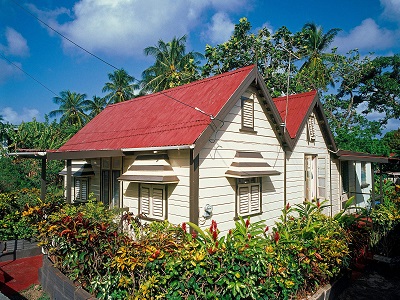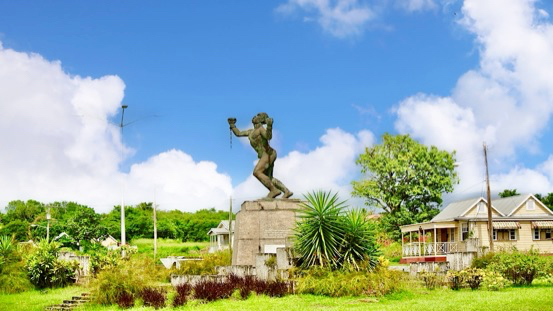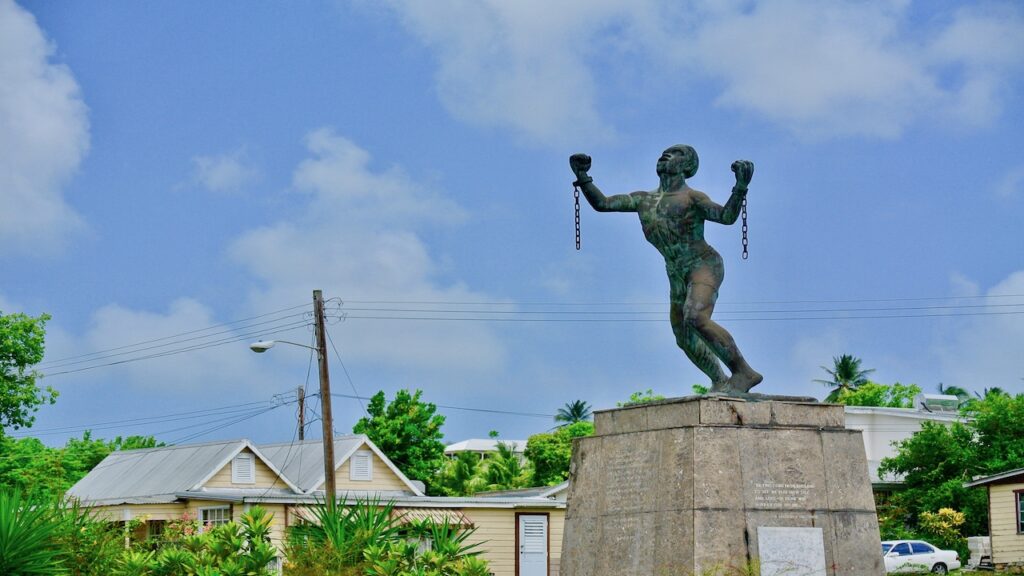Barbados Chattel Houses were the first homes of freedom. Not everyone could afford a house but after a few years of working for pay, several persons were able to save enough to buy a chattel house. They were much prized and stand as an enduring symbol of freedom.
This is the story of the Barbados Chattel Houses told in prose, poetry and images.
Hotels & Villas Inspired by Chattel Houses
Houses Built Upon
Homes where Grandma Settle lived
And where all 8 brothers grew,
living in a room or two
But if it got too tight a squeeze
just add another house to please.
Tiny house built upon,
another house just added on.
Growing with the family size
tiny is no compromise
Tiny House Free to Roam
Free Men Seldom Owned the Land They Built Upon
Many of these tiny Barbados chattel houses were owned by the newly freed enslaved people. But they did not own the land. The land was leased to them and paid for with work in lieu of wages. Their landlord was also their employer and could, at any time, terminate their employment. The house would have to be moved off the land and relocated to wherever they could find a job.
Tiny houses on a coral base
never anchored to the ground
are easily moved in times of hast
when the landlords end the lease
and another land-lot must be found
living by the landlords grace
who could at whim take back their space
Wooden house packed on carts
move off to find another yard
Easy to Configure and Add Upon

The original Chattel Houses were built by freed slaves or plantation workers. As they did not own the land, it was important that the house could be easily taken apart and loaded onto carts for transport to another spot.
This was a precaution in case they were sacked or unable to pay dues to the landlord who owned the land on which their homes stood.
A modern modular design
to be added to
as the family grew
by putting up another shack
like modern buildings made to stack.
They came pre-cut ready to install
as you would a Lego set.
Free Light & Breeze with Filigree & Fret

Little houses built of wood,
Sash window and the jalousies
Fretwork filters dim the light light
To set the shade and cool breeze free.
The fancy filigree fretwork that you see on the roof edging and window frames is both ornament and functional. It filters the burning sunlight, allowing shade and dappled sunshine in to the rooms below.
Windows and doors often had a canopy awning to provide further shade for the room.
A Fading Icon
Little houses falling down
Rumble tumble to the ground
Patchwork, joint and hammered fast
Loved and cherished to the last.
Alas! The charming chattel houses are falling down and many are not being rebuilt, except as ornaments of the past. Proud owners still live in their own house, which they love and cherish. You will see many maintained with love and care. But far too many are not.
Wooden buildings are hard to maintain and the soft Canadian pine of the original houses is very attractive to Barbados termites. They will eat through a tiny house in no time.
There are Chattel Villages, hotels, vacation rentals and villas that are replicas of the chattel house. The many features of the chattel house can be seen in modern buildings and Barbados has several architects that specialise in chattel house design.
Features That Inspire Today’s Architecture
Skilled and crafted
in precise scale
of detail like the villa grand
with pride upon the blocks you stand.
The scale and balance of these timeless homes of wood attest to the craftsmanship of the early African slave population. These men and women where the backbone of Barbados’ economic power. They later became the architects and builders of a new order with a lasting legacy of craftsmanship that has inspired modern building and design.
The freedmen built the chattel house out of imported wood (from Canada). They were pre-cut and ready to be assembled and could be erected with or without the use of nails. They could be configured into many formats, with jalousie louvers and window shutters and doors without glass. The roofs were steep four-sided hip or gable roofs of gavanised metal sheets or wood. The homes would be stacked together to add more living quarters.
Barbados Chattel House – Symbol of Freedom
Freedom – The Chattel House was the first home that the freed slave could own. The long road to freedom was the story of human tragedy of the greatest scale. The slave, Bussa, was an important figure in helping speed up the move to emancipation. Here is a short account of his story.

Bussa was a skilled and able man, earning the confidence of Bayley’s planters. He rose to the rank of ranger (a senior officer) and was respected by many. This was at a time of change, at the end of the slave trade in anticipation of freedom. Frustrated with the slow progress towards freedom, Bussa wanted to see social change and an immediate restructuring of society. In April 1816, he led 400 slaves from various plantations in a revolt against the establishment. The revolt was put down and Bussa was killed in battle. However, the uprising shook the plutocracy and certainly influenced the gathering movement towards emancipation.

In Front of Chattel House 
Bussa coconut trees 
Bussa on pedestal
After emancipation, the white farmers owned the land after establishment but the freed slave men and women could work the land for a wage. In a bizarre statement of attornment, the British government financed the slave owners with grants for the loss of slave workers. The slaves were freed without any compensation from the same British government, in spite of their many years of toil.
This is a vexing issue for which the Caribbean is hoping for reparations. The case involves crimes against humanity, for which there is good precedent. Some experts argue that “today’s prohibitions cannot be applied retroactively”. Source: Wilipedia
The argument at the time was that it was left to the farmers and slave owners to help their previously enslaved people to establish homes and get paid to work the land – and that the British grant took care of that. That is a bit like saying, “You can have slaves but here is some money so you can pay them to work for you”. The problem is that money did little for the new freedmen when it sat in the pockets of their masters.
Some farmers were generous and gave land and housing to their former slaves. Others let them cultivate parcels of land and would buy produce from them. Others paid them wages to do work at their beck and call.
But they were freed by the laws of 1886, which abolished slavery. The new freedmen and women could for the first time choose to work and acquire their own chattel house, which they did with pride.
History
The Barbados Slave Code of 1661 created the legal precedent for slaves to be be treated as chattel property! At the time, it was argued that the law would protect slaves. The wording, however, refers to this protection “as we do men’s other goods and Chattels”. Charming! 200 years later, the Consolidated Slave Law (1826) granted concessions to slaves but still offered reassurances to slave owners. However, change was coming and in just over a decade later, all men would be free.
In 1834, Barbados and the British West Indian colonies abolished slavery but enacted a 4-year apprenticeship for all slaves. The ‘apprenticeship period’ meant that ‘free men’ were to work without pay in exchange for provisions and small housing. 4 years later, on August 1838, all slaves were finally set free. This was the period of full emancipation where former slaves, now free, could now work the land of the plantation owners for a salary.
In 1840, the Located Labours Act allowed former slaves to build on land provided for rent by the plantation owners. The land was rented at low rates and the owners could evict tenants at short notice. Houses, therefore, had to be ‘movable’, hence the name ‘Chattel Houses’. They were built using wood that could be easily taken apart, loaded onto a cart and moved wherever needed.
The Birth of The Chattel House
It is hard to pinpoint exactly when the Chattel House was born. It may have evolved by circumstance rather than due to any gesture or occasion. But certain facts did orchestrate it. In the days of slavery, slaves were housed in barracks and some small houses but these were not chattel house. Slaves and their owners had no need of mobile houses, as they were fixed to a plantation. Furthermore, the small houses for slaves were made from inferior materials, with no thought to design and esthetic.
In 2652, Heinrich von Uchteritz described slaves huts as: “small cabins or huts, “none above six foot square” and “built of inferior wood, almost like dog huts. The roofs were made from plantain leaves, which is very broad and almost shelf-like and serves very well against rain”. (Bridenbaugh and Bridenbaugh 1972, 119).
Over the years, conditions did improve somewhat and houses on some plantations were upgraded to wooden cabins covered with shingles. Source: https://www.liverpoolmuseums.org.uk/archaeologyofslavery/slavery-caribbean
Some today think that slaves may have been given small houses during the first stage of freedom, with indentured work starting in 1834. During the following 4 years, freed slaves were worked as apprentices without pay. They could not afforded a home of their own unless it was given to them.
Even if some plantation owners gifted a small house to their slaves in this period, it would not have been a chattel house. Chattel houses were a staple of a time when freed men owned the house but not the land. Before men were free to own a house, no house needed to be built to move. The stock of small homes in 1834 was just not up to the standards of the chattel house.
Advanced Construction
By contrast, the chattel houses were quality prefabs of advanced construction. The floor was made of tongue and groove planks of 1” x 5” laid on beams of 2” x 4”. The walls were 2” x 4” uprights with a 1” x 5” siding layer over them. The uprights were fixed above and below by mortise and tenon joints. Doors and windows had fixed jalousie louvers.
What made them truly outstanding was the symmetry and standard that they adhered to. Their owner took great pride in maintaining them and painting them in glorious colours to reflect their character.
Finally, the chattel houses were owned by freed men and that means they came after full emancipation in 1834. Considering that slaves and apprentices had no savings, home ownership would have evolved slowly over time.
As the newly freed men improved their social status, the little homes also improved in appearance and function. In time, many became owners of the land and more substantial elements and permanent structures could be added. Homeowners began to add pedimented porches and wrap-around verandas. More substantial windows and canopies became frequent features. They were jalousies or solid bell-shaped window hoods, offering more shade and adding new design elements.
British Compensation – A Tragic Miscarriage of Justice
Slave owners could well have afforded to be generous to their former slaves. They could well have afforded to build them houses and gift them land. We know that some did and some left their estates to their slaves but this was the exception. It did not need to be that way!
The British government paid huge sums in compensation to slave owners and gave nothing to the slaves. Perhaps the government expected slave owners to compensate their workers but there is no evidence of that ever happening.
One must wonder why the British government saw fit to award the slaver owners over £20 million in compensation and give nothing to the slaves. Surely the men who worked as slaves were the rightful recipients of compensation!
The fact is that the slave owners/planters were men of influence. They lobbied hard to receive consideration for a loss of livelihood. Slaves had no representation and could not organize themselves to fight for their rights. It was a course of expediency for the government not encumbered by morality.
Barbados Chattel House Holidays
Why not stay in one of the updated Barbados Chattel Houses or a modern Villa and home build in the style of the chattel house?
Book Of Barbados People & History
Rogues in Paradise – Stories of Barbados people, places, history and heritage. http://roguesinparadise.com
This book will transform you from a casual tourist to an informed traveler. Uncover the island’s mysteries that lie hidden beneath its white sand beaches and luxury facades.
A Lovely 5-Star Book Review
This writing is exceptional it reminds one of Roald Dahl‘s writing in Boy and the first few chapters of Going Solo in the rhetorical flourishes applied to the characters; and a bit of Ruskin Bond‘s flow in the poems and rhythms applied left, right and centre. Readsy
– Savyasachee Jha, Readsy
Find your ideal Barbados accommodation...









